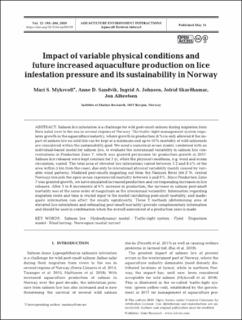| dc.description.abstract | Salmon lice infestation is a challenge for wild post-smolt salmon during migration from their natal river to the sea in several regions of Norway. The traffic-light management system regulates growth in the aquaculture industry, where growth in production (6%) is only allowed if the impact of salmon lice on wild fish can be kept at a minimum and up to 10% mortality of wild salmonids are considered within the sustainability goal. We used a numerical ocean model, combined with an individual-based model for salmon lice, to evaluate the interannual variability in salmon lice concentrations in Production Zone 7, which was granted permission for production growth in 2017. Salmon lice releases were kept constant for 3 yr, while the physical conditions, e.g. wind and ocean circulation, varied. The total area of elevated lice infestations varied between 3.2 and 8.4% of the area within 5 km from the coast, due only to interannual physical variability mainly caused by variable wind patterns. Modeled post-smolts migrating out from the Namsen River (64.5°N, central Norway) towards the open ocean experienced mortality between 5 and 9%. Since Production Zone 7 was granted growth, we have simulated increased production and corresponding increases in lice releases. After 5 to 8 increments of 6% increase in production, the increase in salmon post-smolt mortality was of the same order of magnitude as the interannual variability. Information regarding migration route and time is crucial input to the model calculating post-smolt mortality, and inadequate information can affect the results significantly. These 2 methods (determining area of elevated lice infestations and estimating post-smolt mortality) provide complementary information and should be used in combination when the overall assessment of a production zone is made. | en_US |
